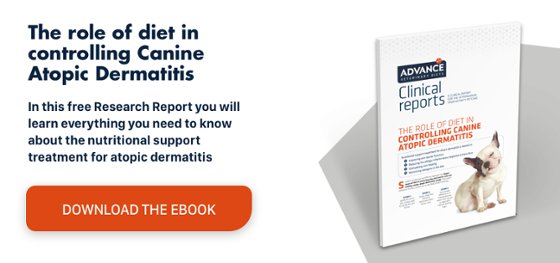Corneal ulcer in dogs and the effect of topical hyaluronic acid
Signs of corneal ulcer in dogs include pain, blepharospasm, enophthalmos, miosis, conjunctival hyperaemia and excessive tearing.
There are two types of corneal ulcer in dogs, superficial and deep ulcers, and the signs depend on the depth of the ulcer. Superficial ulcers are much more painful due to the distribution of sensory nerve fibres. Stimulation of the corneal nerve endings triggers an axonal reflex and is responsible for the onset of clinical signs of anterior uveitis, miosis, reduced intraocular pressure, accumulation of proteins in the anterior chamber, hyphema, hypopyon, fibrin and oedema.
Corneal ulcers in dogs: causes
It is essential to identify and eliminate the factors causing the corneal ulcer. Corneal ulcers may course with pain, blepharospasm, enophthalmos, miosis, protrusion of the nictitating membrane, conjunctival hyperaemia and excessive tearing. These signs will depend on the depth of the ulcer. Superficial ulcers are more painful than deep ulcers. This is due to stimulation of corneal nerve fibres, triggering an axonal reflex and clinical signs of uveitis, miosis, reduced intraocular pressure, accumulation of proteins in the anterior chamber, hyphema, hypopyon, fibrin and oedema. Treatment should be based on the severity of the ulcer and its depth.
The various causes include:
- Lacrimal deficiencies: dry eye, qualitative lacrimal deficiency, meibomitis.
- Palpebral disorders: lagophthalmos, paralysis of the V or VII cranial nerves, ectropion, macropalpebral fissure.
- Anatomical alterations: entropion, distichiasis, trichiasis, ectopic cilia, palpebral tumours and blepharitis.
- External causes: trauma, foreign bodies and caustic agents.
- Infectious causes:
- Protozoal infections: Acanthamoeba keratitis and conjunctivitis with no systemic involvement are rare and may be associated with a pre-existing chronic ocular surface disease treated with long-term immunosuppression.
- Fungal infections: fungal keratitis occurs when there is a predisposing cause, such as an underlying endocrine disorder, pre-existing corneal disease, intraocular surgery and/or prolonged use of topical antibiotics or corticosteroids.
- Ocular manifestations in dogs with leishmaniasis.
- Virus: the administration of a systemic immunosuppressive dose of prednisolone to adult dogs with latent CHV-1 infection can reactivate the disease causing a flare-up of the ocular signs.
- Others: keratitis associated with topical carbonic anhydrase inhibitors (CAI) used to treat glaucoma in dogs. It is important to consider that these dogs could develop punctate keratitis and severe diffuse keratitis as sides effects of topical CAI administration, even if the treatment has been used previously without complications.
Corneal ulcers in dogs: treatment
Treatment is determined by the depth and severity of the ulcer. A topical antibiotic is generally applied according to the culture or cytology results.
Complicated ulcers course with uveitis, in which case nonsteroidal anti-inflammatory drugs and oral corticosteroids are indicated. The application of topical corticosteroids is strictly contraindicated for corneal ulcers because they delay healing and enhance the action of collagenase. The use of cycloplegic agents will relieve ciliary muscle spasms and prevent the formation of synechiae.
According to a pilot study carried out on damaged corneas of Beagles, the application of 0.2% hyaluronic acid together with standard medical treatment for corneal ulcers is well tolerated. It was also noted that use of a topical viscoelastic does not accelerate corneal wound healing compared to a topical control of similar viscosity.
Other treatment options suggested by various studies are thermal cauterisation under sedation and with the aid of small incisions to treat spontaneous chronic corneal epithelial defects; the use of corneal grafting of porcine small intestinal submucosa for corneal reconstruction, resulting in corneal transparency in most cases as an alternative to the conventional technique involving conjunctival grafts; and the use of a cyanoacrylate adhesive as a simple, safe and noninvasive method to treat refractory corneal ulcers in dogs.

